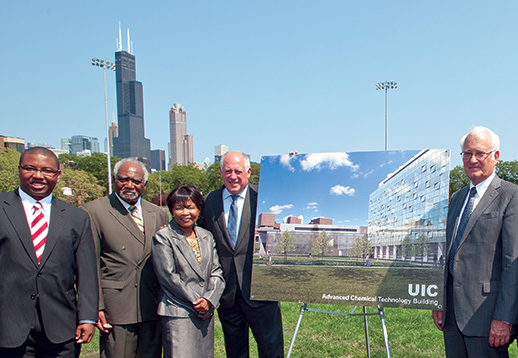New research facility ‘more than a building’

At the site of the future Advanced Chemical Technology Building: L-R, UIC student trustee Ken Thomas, U.S. Rep. Danny Davis, Chancellor Paula Allen-Meares, Gov. Pat Quinn, University President Bob Easter.
Photo: Roberta Dupuis-Devlin
Transformative. Energizing. A renaissance for science and engineering at UIC.
That’s how UIC researchers in chemistry, biology and physics describe the $104 million Advanced Chemical Technology Building announced Aug. 29 by state and campus dignitaries, including Gov. Pat Quinn.
“This facility is more than a building,” said Chancellor Paula Allen-Meares at last week’s press conference near the facility’s future site, just south of the Science and Engineering South Building.
“It is the tangible commitment that UIC is serious about interdisciplinary innovative, cutting-edge research collaborations to expand our knowledge for and our contributions to the betterment of humankind.”
The ACTB will foster interdisciplinary research in neuroscience, nanoscience, bioscience and other areas. Construction will begin in FY14 and take about 30 months to complete.
The building could be a “change event,” said University President Bob Easter.
“I read once that interdisciplinary research is what makes science fiction, science reality,” he said. “We have the opportunity here for real innovation.”
The ACTB has been in the planning for two decades. The legislature approved construction funding for FY03 and a design was approved by the University of Illinois Board of Trustees in November 2004. Last week, Quinn announced the release of $64 million in state funds for the project. The university will pay the remaining costs.
“The best investment a state can make is in education,” Quinn said. “We believe in our students and we want them to stay in Illinois after they graduate.”
With a design that encourages collaboration between scientists, the building will have space for researchers in chemistry, biology and physics, working on projects related to areas such as tumor growth, HIV/AIDS, immunology, dentistry, orthopedics and environmental science.
“The new building promotes interactions that may be transformative,” said Brian Kay, professor and head of biological sciences.
The ACTB will provide much-needed space for synthesis laboratories, lasers, spectrographic instruments, cell and tissue culture and other experiments sensitive to vibration and temperature, said Luke Hanley, professor and head of chemistry.
Its conference facilities can host seminars that bring researchers from all the sciences and engineering together, Hanley said.
“The new ACTB offers the possibility of a renaissance for science and engineering on the UIC campus,” he added.
The building will be designed for top ratings in sustainability, with a Leadership in Energy and Environmental Design (LEED) standard of silver or higher.
“This building and the researchers who will occupy it are a game changer for UIC,” said David Hofman, professor and head of physics.
“It will put UIC science on the cusp of research for the 21st century.”
